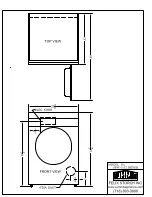
.10.
Installation
Positioning the Appliance
Positioning the appliance in the desired location.The back should
rest against the wall behind it,and the sides,along the adjacent
cabinets or wall.The dishwasher is equipped with water supply
and drain hoses that can be positioned to the right or the left to
facilitate proper installation.
Levelling the Appliance
Once the appliance is positioned,adjust the feet (screwing them
in or out) to adjust the dishwasher,making it level.In any case,
the appliance should not be inclined more than 2
.If the appli-
ance is level,it will help ensure proper performance.
Cold Water Connection
Connect the cold water supply hose to a threaded 3/4(gas)con-
nector and make sure that it is fastened tightly in place (see
figure1).
If the water pipes are new or have not been used for an extended
period of time,let the water run to make sure that the water is
clear and free of impurities.If this precaution is not taken,there is
a risk that the water inlet can get blocked and damage the
appliance.
The connection must be made to the hot water line following the
same procedures as those for the connection to the cold water
line.
Anti-Flooding Protection
The dishwasher is equipped with a system that stops the supply of
water in the event of a problem with the water supply hose,or leaks
within the unit,in order to prevent damage to your home.If for any
reason the box containing the electrical components happens to
get damaged,remove the plug for the appliance from the socket
immediately.In order to guarantee that the anti-flooding feature
operates properly,the"A"box with water supply hose must be at-
tached to the water supply tap as shown in Fig .1.No other type of
connection is acceptable.The water supply hose must not,under
any circumstances,be cut,as it contains electrical parts which are
live.If the length of the hose is not adequate to make a proper
connection,the hose must be replaced with one whith is long
enough.This hose is available upon request from specialised re-
tailers and service centres.
Drain Hose Connection
Insert the drain hose into a drain pipe with a minimum diameter
of 4cm,Or let it run into the sink,making sure to avoid bending
or crimping it.Use the speical plastic support that comes with
the appliance (see fig.C).The free end of the hose must be at a
height between 40 and 100 cm and must not be immersed in
water.
Attention:
The special plastic hose support must be solidly fastened to the
wall to prevent the drain hose from moving and allowing water to
spill outside the drain.
Electrical Connection
After making sure that the voltage and frequency values for the
current in the home correspond to those on the rating plate
(located on the staunless steel inner door of the appliance) and
that the electrical system is sizedd for the maximum voltage on
the rating plate,insert the plug into an electrical socket which is
earthed properly (the earthing of the appliance is a safety re-
quirement mandated by law).
If the electrical socket to which the appliance must be connected
is not appropriate for the plug,replace the plug ,rather than us-
ing adpators or the like as they could cause overheating and
burns.
Installation
Hot Water Connection
The water supply to the appliance can also be connected to the
house's hot water line (centralised system,heating system),as long
as it does not exceed a temperature of 60
.
In this case,the wash cycle time will be shortened by about 15
minutes and the wash efficiency slightly reduced.
fig.C
GB






























